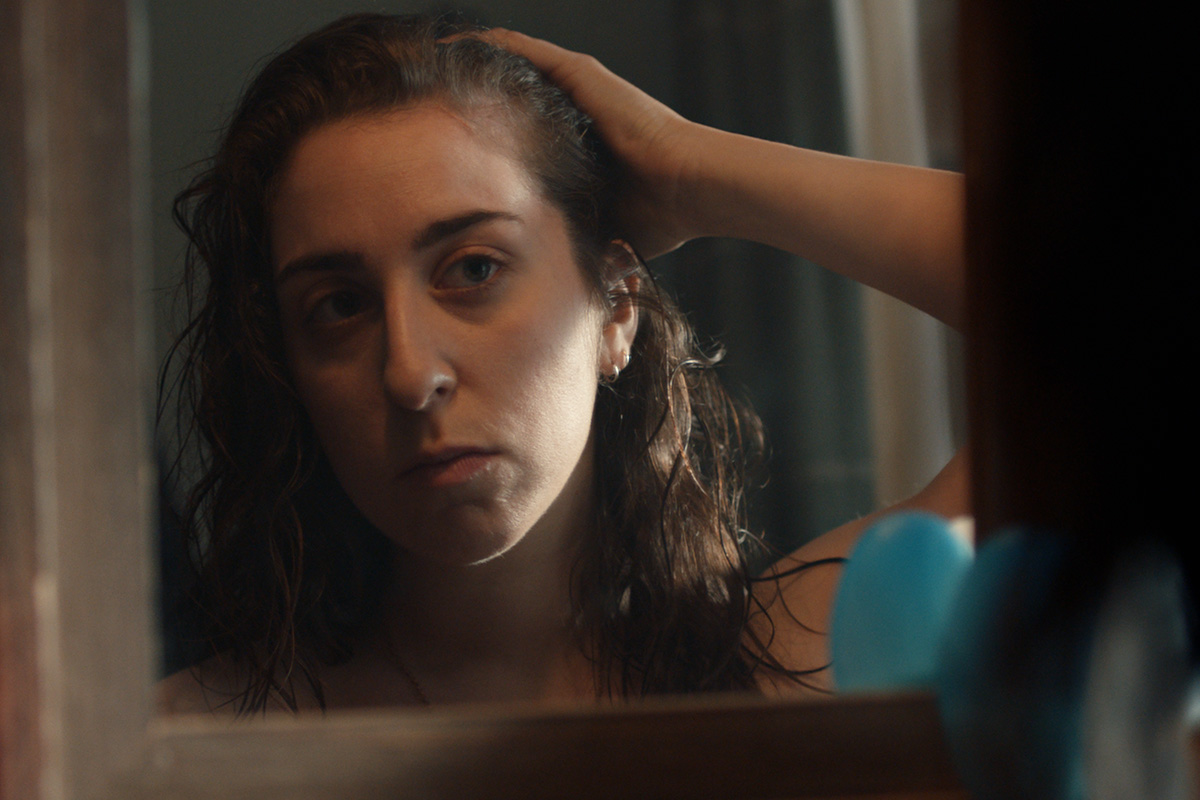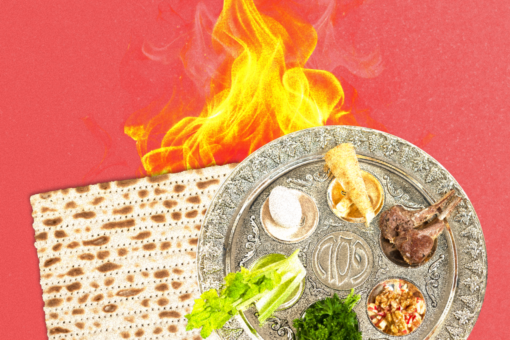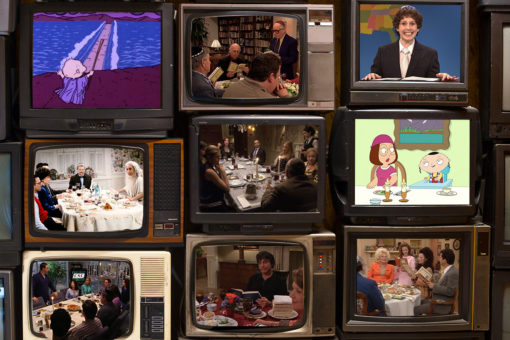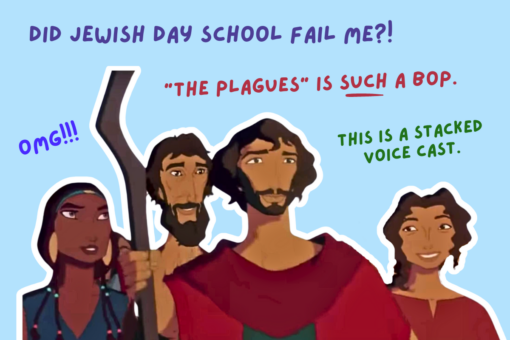In a world where Netflix keeps pumping out endless Christmas rom-coms, we need more Jewish holiday movies. “What She Said” writer, star and co-producer Jenny Lester is a self-described “nice Jewish girl” from L.A.’s San Fernando Valley. She didn’t set out to create a holiday film. But after experiencing her first-ever Christmas celebration with “What She Said” director Amy Northup and co-producer Juliana Jurenas in a Virginia cabin, she knew she had something to say about how American Reform Jews experience the winter holidays.
In her new movie, you can expect to see Hanukkah sweaters, twinkling Christmas trees and siblings noshing on pumpkin pie. (The film actually takes place over Thanksgiving, but the characters decide to ignore the fraught holiday — “Maybe let’s skip the holiday that glorifies genocide and rape” — and instead start decorating for Christmas and Hanukkah.) You can also expect an important discussion about sexual assault and the methods people use to heal.
I’ve been friends with the Lester family since we were children. From a young age, Jenny and her sisters Lily and Julia were making moves — staging talent shows for our parents and starring in their high school musicals. Now, they’re making movies and starring on the Disney+ series “High School Musical: The Musical: The Series.”
The Lester girls are each other’s biggest champions, so “What She Said” is a family affair from start to finish. Julia, who plays Ashlyn Caswell on the aforementioned Disney+ show, co-produced the film. The Lesters’ mother, actress Kelly Lester, provided voiceover for the opening scene. The girls’ own bond influenced the characters’ sibling relationships.
But that inclusive spirit isn’t just on screen — it was also behind the camera. An almost entirely female and nonbinary crew made the movie.
I spoke with Jenny and Julia about “What She Said,” the importance of diverse Jewish representation on TV and in film, and their own favorite holiday traditions.
This interview has been lightly condensed and edited for clarity.
Your movie feels so familiar and comfortable. Did any other films influence you? It reminds me of the family togetherness of “Hannah and Her Sisters” mixed with “The Big Chill.”
Jenny: You know, what’s funny is we were going through the process of writing and developing it and so many people were like, “Oh, ‘The Big Chill!’” But we’ve never seen it. I didn’t watch that until I was almost done writing [“What She Said”]. We are sort of obsessed with the Lynn Shelton and Duplass brothers world. I watched “Your Sister’s Sister” a thousand times, which is about three people in a cabin. We also really like the movies “About Alex” and Clea DuVall’s “Intervention.” I love everyone-under-one-roof narratives. I love “Obvious Child.” I watched it like five times while I was writing my movie.
One of the best moments was when we locked the final version and saw an early screening on the big screen. I turned to Juliana and said, “We made the kind of movie that we love.”
So how does a nice Jewish girl from the San Fernando Valley get all the way out to Rappahannock County, Virginia, where your film takes place, to make a movie?
Jenny: Our location was the first thing that happened. I had my first-ever Christmas with Amy and Juliana’s family — they’re cousins. They invited me to come to that exact cabin for Christmas and I was like, “What is this? This is so cozy!” I told my sister, “Julia, we’ve got to make a movie here.”
Your movie is supremely cozy. The characters all wear the snuggliest sweaters while sipping steaming mugs of coffee and hanging holiday decorations. But that’s all in stark contrast to the film’s central plot: surviving sexual assault. Was that an intentional decision?
Jenny: I think that for survivors of sexual assault, there is this desire to return to who they were before the trauma. That was a deliberate choice, to return to the cozy. When the #MeToo movement began, I was reading a lot of survivor impact statements and stories online that really impacted me and inspired the story in “What She Said.” The two things came together in a natural way.
It’s not a trauma porn movie. At its core, it’s a story about healing. When we heal, we often return to the things that make us feel the most cozy and the things that are the most familiar, like your family and your chosen people.
The movie starts a conversation, but it’s not telling you how to feel or think. We tried to give a very wide range of opinions and ways that people deal with [sexual assault]. My hope is that somewhere in there you see yourself, and can connect to this topic in a way that doesn’t feel like a lecture.
Julia: In one scene, Sam [the main character] is eating leftover pumpkin pie on the floor and all of her siblings come join in. It always makes me cry. It’s really heart-warming and comforting to watch people love each other and be in a comfortable space with each other. I think that’s appealing to everybody.
You cast some of your real-life friends in this film. Did that bring a level of authenticity and familiarity to the piece for you?
Jenny: It really felt like a family experience on set. My longtime friend Juliana and I conceived this thing from the get-go. We brought in her cousin to direct. I wrote the character Becca for my high school friend Paige. It was such a joy to be able to sketch in the other newer friends and actors that we auditioned to fill out this group.
There are no A-list stars in this movie. The whole thing was made on grit and audacity alone. We’re a bunch of first-time filmmakers. Most of the actors came from theater and had never done a movie before. The thing that got this made was the community who believed in it, including my sister Julia who said, “I’m helping you get this over the finish line.”
Julia: I just think that Jenny is insanely talented. The script for “What She Said” is incredible. She’s the perfect person to act in it as well. I have always believed in her wholeheartedly and in everything that she is. It was a no-brainer when I was presented with this opportunity.
But it wasn’t always this way! I’ve known both of you practically since birth and I remember all those petty sister fights over the smallest thing. It’s so impressive to see you guys supporting each other now.
Julia: Being adults with your sisters is really cool. We’re all such great friends now.
Jenny: It’s so amazing. We used to kill each other! But now we’re adults and we champion each other in different ways. I’m always so excited to watch Julia on “High School Musical: The Musical: The Series” every week, and I’m so proud of her. I love watching my sister Lily [the middle Lester sister] do stand-up. We’re all performing, but we’re all doing really different things, so we can just be cheerleaders for each other. Haim who? There are three new Jews from the West Valley!
Speaking of Judaism, your movie excellently represents American Reform Jewish siblings celebrating their own traditions. It’s a mish-mosh of all the winter holidays with the thread of Jewish family traditions and ideologies.
Julia: I think Jewish family representation on TV and in movies is really important, and that includes Reform Jewish families. We grew up very much Reform, and I didn’t see a lot of movies about families like mine. Aside from the fact that Jenny is my sister and the film has some influences from our own family thrown into it, if I were just a viewer I would feel really comforted seeing Jewish siblings and their friends get together to celebrate the holidays in a really inclusive way. It’s a great representation of modern Jews and how they celebrate with their family and friends.
Jenny: Growing up, we had the “Rugrats” Passover episode and that was it. I think for all of the secular Jews that I know, the importance of the culture comes down to ritual and gathering, not so much the religiosity of it. We’ve adopted an Americanized version of our Jewish rituals.
I’m thinking about it even more because in the last week, an article came out about non-Jewish actresses being cast to play very Jewish roles. Sarah Silverman talked a lot about it on her podcast. This article was talking about the flattening of Jewishness in main character roles, while Jewish actresses are being cast as the funny best friend or as very religious. It’s a flattening experience because Jews look like everything and are from everywhere and practice in many different ways. Letting Jewish actors be the hero of their own story is important. It seems rather insidious when you see how few Jewish actresses are leading their own stories.
So besides being a Jewish woman choosing to write the story of a Jewish character, you also chose to hire a crew of mainly female and nonbinary folks to make this. Did that shape the experience of making the movie at all?
Jenny: It was the best decision we ever made. There was something so incredible about it. We shot in a small town and we would go on location scouts with all the department heads. So it was eight different women walking around. And we would go into small places, and there would usually be a man there who owned the [place] who would ask, “Well, who is in charge?” And we would respond, “Us.” That was so empowering. It was also so unexpected to the people there.
Lastly, what are your favorite Lester family traditions?
Jenny: We grew up not eating meat as a family, so the shank bone on the seder plate every Passover always really grossed us out. So my dad started putting a Butterfinger [candy bar] on it instead. So now it’s a tradition to have a Butterfinger on our Passover seder plate.
Julia: We weren’t allowed to eat the Butterfinger. The Butterfinger is always frozen and used for the next year.
Jenny: I have no idea how many years that one Butterfinger went on for?
Julia: It’s called the Butterfinger. There’s only one, clearly!
“What She Said” was released in September 2021 and is available to stream online.



